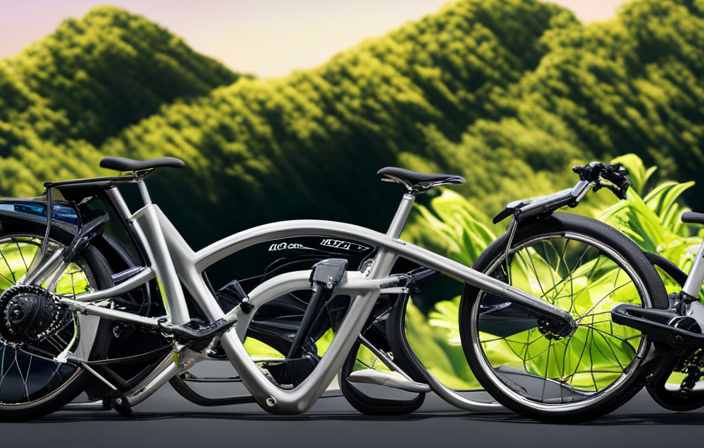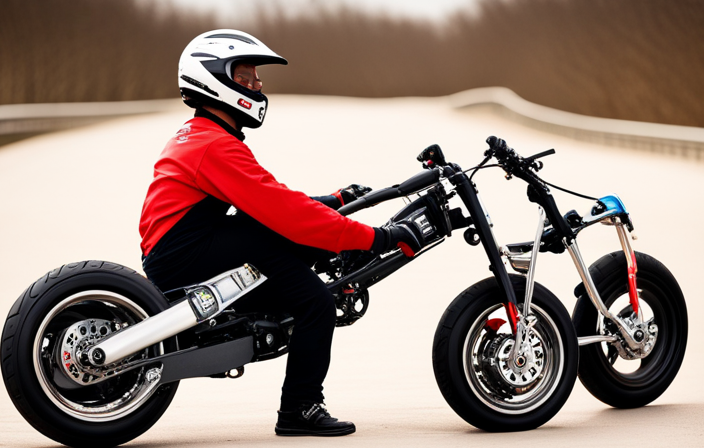Are you ready to dive into the world of electric bike batteries and explore how much they really cost? Hold onto your handlebars, because we’re about to shed light on this burning question.
As the saying goes, ‘knowledge is power,’ and in this case, it’s the power that keeps your electric bike going. In this article, we’ll break down the various factors that affect the price of electric bike batteries, compare different options, and discuss additional costs to consider.
So, let’s take a ride and find out exactly how much an electric bike battery will set you back.
Key Takeaways
- Lithium-ion batteries are the most expensive, but they offer high energy density, long lifespan, and faster charging times.
- Nickel-cadmium batteries are more affordable, have a shorter range, but are durable and can handle extreme temperatures.
- Lead-acid batteries are the cheapest option, suitable for shorter commutes, but they are heavier and have a shorter lifespan.
- Factors such as capacity, battery chemistry, and lifespan factors affect the price of electric bike batteries.
Types of Electric Bike Batteries
There are different types of electric bike batteries available on the market. The most common types include lithium-ion, nickel-cadmium, and lead-acid batteries. Each type has its own advantages and disadvantages.
Lithium-ion batteries are the most popular choice for electric bikes due to their high energy density, lightweight design, and longer lifespan. They offer a greater range and faster charging times compared to other battery types. However, they tend to be more expensive.
Nickel-cadmium batteries are known for their durability and ability to handle extreme temperatures. They are also more affordable than lithium-ion batteries. However, they have a lower energy density, which means a shorter range per charge.
Lead-acid batteries are the least expensive option, but they are also heavier and have a shorter lifespan. They are suitable for shorter commutes and offer a lower range compared to lithium-ion and nickel-cadmium batteries.
Considering the types of batteries and their pros and cons, it’s important to also consider other factors affecting the price of an electric bike battery.
Factors Affecting the Price
One of the main factors that affects the price of an e-bike battery is its capacity. The capacity of a battery refers to the amount of energy it can store, and it is usually measured in watt-hours (Wh). Batteries with higher capacities tend to be more expensive because they can provide more power and have a longer range.
Aside from capacity, there are other factors that can affect the price of an electric bike battery. One of these factors is the type of battery chemistry used. Different battery chemistries, such as lithium-ion or nickel-metal hydride, have varying costs and performance characteristics. Additionally, factors affecting the lifespan of the battery, such as the number of charge cycles it can endure or the quality of the cells used, can also impact the price.
Considering these factors, it is important to compare battery prices to ensure you get the best value for your money.
Comparing Battery Prices
When comparing battery prices for electric bikes, you will find that lithium-ion batteries tend to have the highest price range. These batteries are known for their high energy density and long lifespan, making them a popular choice among electric bike users.
On the other hand, NiMH batteries have a lower price range compared to lithium-ion batteries but still offer decent performance.
Lastly, lead-acid batteries have the lowest price range among these three options, but they are also heavier and have a shorter lifespan.
Price Range for Lithium-ion Batteries
The price range for lithium-ion batteries for electric bikes varies depending on several factors affecting performance.
One of the main factors is the battery size, as larger batteries tend to have a higher capacity and longer range. The price of a lithium-ion battery can range from around $200 to $800 or more, depending on the brand, quality, and capacity. Higher capacity batteries with advanced features such as fast charging or Bluetooth connectivity may be on the higher end of the price range.
It’s important to consider the specific needs of your electric bike and choose a battery that aligns with those requirements.
Moving on to the price range for nickel-metal hydride (NiMH) batteries…
Price Range for NiMH Batteries
To determine the price range for nickel-metal hydride (NiMH) batteries, you’ll need to consider factors such as brand, quality, and capacity. NiMH batteries are known for their longer lifespan compared to other battery types, with an average life of around 3-5 years. This extended lifespan is due to their ability to handle a higher number of charge-discharge cycles.
In addition to their durability, NiMH batteries also offer advantages such as a higher energy density, which allows for a longer range on electric bikes. When it comes to pricing, NiMH batteries tend to be more affordable than lithium-ion batteries, with prices ranging from $200 to $600 depending on the brand and capacity.
Now, let’s move on to discussing the price range for lead-acid batteries, another popular option for electric bike enthusiasts.
Price Range for Lead-Acid Batteries
Lead-acid batteries have a price range that varies depending on brand and capacity. When it comes to electric bike batteries, lead-acid batteries are generally cheaper compared to other types. The price range for lead-acid batteries can range from around $100 to $300 or more.
The lifespan of lead-acid batteries is influenced by several factors, such as the depth of discharge, temperature, and maintenance. These batteries have a moderate lifespan, typically lasting around 2 to 4 years.
One of the advantages of lead-acid batteries is their affordability, but they also have some drawbacks. They are heavy and bulky, which can affect the overall weight and performance of the electric bike. Additionally, lead-acid batteries require regular maintenance, such as checking the water levels and avoiding overcharging.
Considering the pros and cons of lead-acid batteries, it is important to factor in the additional costs to consider when purchasing an electric bike.
Additional Costs to Consider
One important factor to consider when purchasing an electric bike is the cost of the battery. While the price of the battery itself varies depending on factors such as brand and capacity, there are also additional costs to consider.
Here are three important factors to keep in mind when calculating the overall cost of an electric bike battery:
-
Additional installation costs: Some electric bike batteries require professional installation, which can add to the overall cost. It is important to factor in these installation costs when determining the total price of the battery.
-
Impact on range: The capacity of the battery plays a crucial role in determining the range of your electric bike. Higher-capacity batteries generally offer longer ranges, but they can also come at a higher price. Consider your specific needs and usage patterns to determine the appropriate battery capacity for your electric bike.
-
Maintenance and replacement: Over time, electric bike batteries may require maintenance or even replacement. It is important to factor in these potential costs when considering the overall cost of the battery.
Investing in a higher-quality battery can offer numerous benefits, including improved performance and longevity.
Benefits of Investing in a Higher-Quality Battery
When you invest in a higher-quality battery, you can experience improved performance and longer lifespan. Higher performance options not only provide more power, but they also offer better efficiency and faster charging times. This means you can ride your electric bike for longer distances and spend less time waiting for your battery to recharge. Additionally, a higher-quality battery is likely to have a longer lifespan, saving you money in the long run. While the upfront cost may be higher, the long-term savings and enhanced performance make it a worthwhile investment. To help you understand the benefits of investing in a higher-quality battery, consider the following table:
| Lower-Quality Battery | Higher-Quality Battery |
|---|---|
| Less power | More power |
| Slower charging | Faster charging |
| Shorter lifespan | Longer lifespan |
Investing in a higher-quality battery not only improves your electric bike’s performance, but it also saves you money in the long term. In the next section, we will provide tips for extending battery life.
Tips for Extending Battery Life
To extend the life of your electric bike battery, there are three important tips to keep in mind.
First, make sure to properly charge and discharge the battery. This means avoiding overcharging or completely draining the battery, as both can have a negative impact on its lifespan.
Secondly, storing the battery correctly is crucial. Keeping it in a cool, dry place and avoiding extreme temperatures will help preserve its performance.
Lastly, regular maintenance is key. This includes cleaning the battery and checking for any signs of damage or wear.
By following these tips, you can maximize the lifespan of your electric bike battery and ensure optimal performance.
Proper Charging and Discharging
Charging and discharging an electric bike battery properly is crucial for its longevity. To maximize charging efficiency and extend the battery lifespan, make sure to follow these tips.
Firstly, always use the charger that comes with your electric bike as it is specifically designed for your battery. Avoid using generic chargers or chargers with different voltage outputs, as they can damage the battery.
Secondly, charge the battery fully before each ride and avoid frequent partial charging, as it can reduce the overall capacity of the battery over time.
Additionally, it is important to discharge the battery regularly to prevent it from staying at full charge for extended periods, which can also affect its performance.
By following these guidelines, you can ensure that your electric bike battery lasts longer and performs optimally.
Now, let’s move on to the next section about storing the battery correctly.
Storing the Battery Correctly
To ensure the longevity and optimal performance of your electric bike battery, it is crucial to store it correctly. Proper storage not only protects the battery but also ensures its longevity and efficiency.
When storing your battery, make sure to keep it in a cool, dry place. Extreme temperatures can have a negative impact on the battery’s performance. Additionally, it is important to maintain a charge level between 30% to 50% when storing the battery for an extended period. This helps prevent over-discharge or overcharging, which can damage the battery.
Remember to remove the battery from the bike if you plan to store it for a long time, as this prevents unnecessary power drain. Following these storage guidelines will contribute to the overall battery maintenance.
Now, let’s move on to regular maintenance for your electric bike.
Regular Maintenance
Make sure you regularly check and clean the components of your e-bike to keep it in good working condition. Regular maintenance is important for the longevity of your electric bike battery. By following a few simple steps, you can ensure that your battery stays in optimal condition for as long as possible. First, make sure you charge your battery regularly, even if you haven’t used your e-bike. This helps to prevent the battery from fully discharging, which can shorten its lifespan. Additionally, it is important to clean the battery terminals and connectors to prevent corrosion and ensure a good connection. Lastly, avoid exposing the battery to extreme temperatures, as this can also affect its performance and lifespan. By taking these steps, you can maximize your battery’s lifespan and enjoy your e-bike for years to come. Now, let’s explore some budget-friendly options for electric bike batteries.
Budget-Friendly Options
Looking for a budget-friendly option? You can get an electric bike battery at an affordable price. There are several affordable alternatives to consider when it comes to purchasing a new battery for your electric bike.
One option is to look for second hand options. Many people upgrade their electric bike batteries and sell their old ones at a lower price. This can be a great way to save money while still getting a quality battery.
Additionally, some online retailers offer discounted prices on electric bike batteries, especially during sales or promotions. It’s important to do your research and compare prices to find the best deal.
Now, let’s talk about the importance of battery warranty and how it can protect your investment.
Importance of Battery Warranty
When it comes to buying an electric bike battery, understanding the warranty coverage is crucial.
A good warranty can provide you with peace of mind and protection against any potential issues or defects.
It’s important to choose a battery with a good warranty that covers not only manufacturing defects but also performance degradation over time.
By doing so, you can ensure that your investment is protected and that you’ll have a reliable and long-lasting battery for your electric bike.
Understanding Warranty Coverage
If you take good care of your electric bike battery, you’ll likely enjoy the benefits of warranty coverage. Understanding the details of your warranty coverage is important to ensure that you make the most of it. Here are three key things to know about warranty coverage for electric bike batteries:
-
Battery lifespan: Warranty coverage often includes a specified duration for the battery’s lifespan. This means that if your battery fails within the warranty period due to manufacturing defects or premature wear, you may be eligible for a replacement or repair.
-
Battery performance: Warranty coverage may also consider the performance of the battery. If your battery’s performance deteriorates significantly below a certain threshold during the warranty period, you may be entitled to a replacement.
-
Exclusions and limitations: It’s crucial to understand any exclusions or limitations in your warranty coverage. Some warranties may not cover damage caused by misuse, neglect, or accidents.
By understanding the specifics of your warranty coverage, you can make an informed decision when choosing a battery with a good warranty.
Choosing a Battery with a Good Warranty
Now that you understand the importance of warranty coverage for your electric bike battery, let’s delve into the process of choosing a battery with a good warranty.
One crucial aspect to consider is battery capacity. The capacity determines how much energy the battery can store, and it directly impacts the range of your electric bike. A higher capacity battery will allow you to travel longer distances without needing to recharge.
Additionally, when comparing battery performance, pay attention to factors such as charge time, lifespan, and overall reliability. Look for batteries that are known for their durability and consistent performance over time.
By considering both battery capacity and performance, you can ensure that you make an informed decision when choosing the right battery for your electric bike.
Now, let’s explore the subsequent section about the environmental impact of electric bike batteries.
Environmental Impact
To calculate the environmental impact of an electric bike battery, you can compare it to the emissions produced by traditional gasoline-powered vehicles. Electric bike batteries have a significantly lower carbon footprint compared to gasoline engines. Here are three key factors that contribute to their long-term sustainability:
-
Energy Efficiency: Electric bikes convert a higher percentage of energy from the battery into motion, reducing energy waste and minimizing environmental impact.
-
Sustainable Materials: Many electric bike batteries are made with recyclable materials, reducing the need for resource extraction and minimizing waste.
-
Renewable Energy: Charging electric bike batteries with renewable energy sources, such as solar power, further reduces their environmental impact and promotes sustainability.
Considering the reduced carbon emissions, use of sustainable materials, and the option to charge with renewable energy, electric bike batteries are a greener alternative to traditional transportation options.
In conclusion, the environmental impact of electric bike batteries is significantly lower than that of gasoline-powered vehicles, making them a more sustainable choice for transportation.
Conclusion and Final Thoughts
In conclusion, you should consider the environmental impact and long-term sustainability when choosing your mode of transportation.
When it comes to electric bike batteries, there are budget-friendly options available that can help minimize the environmental impact. These batteries are designed to be rechargeable and have a longer lifespan compared to traditional bike batteries.
By opting for an electric bike with a budget-friendly battery, you can reduce your carbon footprint and contribute to a cleaner environment. Additionally, these batteries can save you money in the long run as they require less maintenance and have a lower cost per charge compared to other options.
So, when making your decision, remember to prioritize the environmental impact and choose a budget-friendly electric bike battery that aligns with your sustainability goals.
Frequently Asked Questions
Can I use any electric bike battery with my electric bike, or are there specific batteries that are compatible with certain models?
Yes, there are specific electric bike battery types that are compatible with certain models. Different electric bikes may have different charging options, so it’s important to choose a battery that is suitable for your specific bike model.
Are there any safety precautions or maintenance requirements that come with owning an electric bike battery?
To ensure safety and optimal performance, there are a few important maintenance requirements and safety precautions to follow when owning an electric bike battery. These include proper storage, regular charging, avoiding extreme temperatures, and inspecting for damage or wear.
How do I know when it’s time to replace my electric bike battery?
When the power of your electric bike starts to fade, it’s a sign of battery deterioration. To extend its lifespan, avoid extreme temperatures, charge it regularly, and store it properly.
Are there any government incentives or subsidies available for purchasing an electric bike battery?
Yes, there are government incentives and subsidies available for purchasing an electric bike battery. These programs can help offset the cost and make it more affordable for you to go green and enjoy the benefits of an electric bike.
Can I upgrade my electric bike battery to a higher capacity or longer-lasting option in the future?
Yes, you can upgrade your electric bike battery to a higher capacity or longer-lasting option in the future. Higher capacity is important for longer rides, but longer-lasting batteries ensure a better overall lifespan. It’s not recommended to mix and match different brands for better performance.
Conclusion
So, now that you’re well-informed about the different types of electric bike batteries, the factors that affect their price, and the additional costs to consider, you’re probably wondering just how much you’ll need to invest.
Well, let me tell you, the price range can vary greatly depending on the brand, capacity, and quality of the battery. But here’s the thing – investing in a higher-quality battery might cost you more upfront, but it will definitely pay off in the long run.
Not only will you enjoy a longer lifespan and better performance, but you’ll also contribute to a greener and more sustainable future. So, don’t skimp on quality when it comes to your electric bike battery – it’s a decision you won’t regret.















